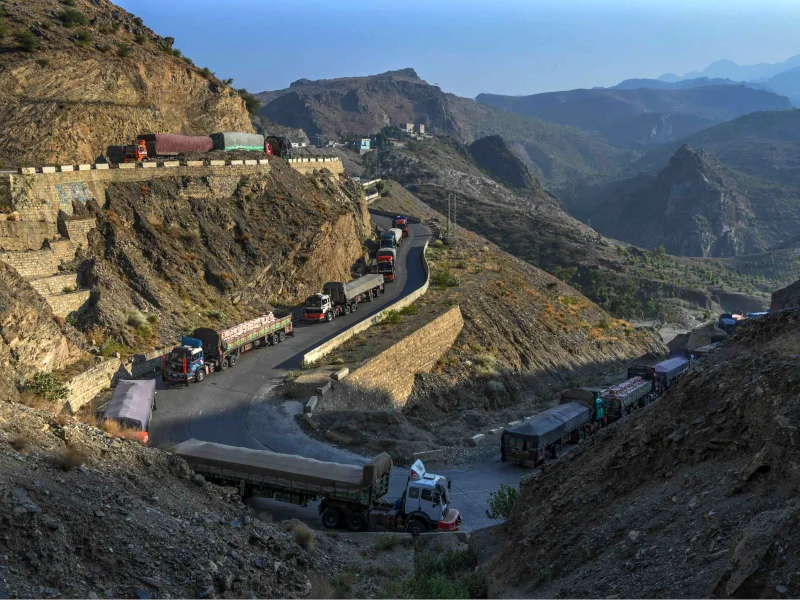The economic ties between Afghanistan and Pakistan are deeply intertwined, shaped by shared geography, history, and a natural need for cooperation. With a 2,640-kilometer border between them, the two countries have a long history of trade, transit, and cultural exchange. While their economic relationship has faced various challenges, it has also fostered significant cooperation and mutual benefits. This interdependence is marked by a series of commercial, infrastructural, and humanitarian connections that offer substantial opportunities for growth.
A Strong Trade Relationship
Pakistan is one of Afghanistan’s largest trading partners. Prior to the Afghan Interim Government’s return to power in 2021, bilateral trade averaged around $2–3 billion annually, with informal trade, such as smuggling, likely doubling this figure. The partnership between the two nations is grounded in a wide array of trade exchanges:
- Pakistani Exports to Afghanistan: Pakistan plays a key role in supplying Afghanistan with essential goods, including cement (on which Afghanistan relies for 90% of its needs), sugar, wheat, pharmaceuticals, textiles, and machinery.
- Afghan Exports to Pakistan: Afghanistan contributes a wealth of agricultural products such as fresh and dried fruits (pomegranates, grapes, apricots), nuts (pistachios, almonds), and handicrafts. These products are not only vital to Afghanistan’s economy but are also significant for Pakistan’s consumption and export markets.
- Transit Trade: Afghanistan’s landlocked position makes Pakistan’s ports, notably Karachi and Gwadar, essential for the country’s trade. The Afghan Transit Trade Agreement (APTTA), which has been renewed in 2023, facilitates this exchange by allowing Afghan trucks to transit Pakistani ports and access global markets.
The Afghanistan-Pakistan Transit Trade Agreement (APTTA)
The APTTA, signed in 2010 and renewed in 2023, is a crucial framework that governs formal trade relations. Under this agreement, Afghanistan benefits from duty-free access for goods entering Pakistan, as well as streamlined customs procedures at key border crossings like Torkham and Chaman. In 2023, the agreement was updated to allow Afghan exports to reach India via the Wagah border, albeit with certain restrictions.
This formal trade arrangement has opened up avenues for economic growth, but challenges like non-tariff barriers, corruption, and bureaucratic delays continue to hinder its full potential. However, the agreement remains a cornerstone of Afghanistan-Pakistan trade, offering tangible benefits to both nations.
Overcoming Challenges to Enhance Trade
While the trade relationship holds great promise, several challenges persist, often stemming from political tensions, infrastructure gaps, and informal trade.
- Political Tensions and Security Concerns: Cross-border attacks and accusations of harboring militants, such as the Tehrik-i-Taliban Pakistan (TTP), often lead to border closures. These security issues strain the trust between the two countries, as seen in 2023 when clashes at the Torkham border resulted in weeks of halted trade, disrupting the flow of goods and stranding thousands of trucks.
- Smuggling and Informal Trade: Smuggling of goods, including fuel, electronics, and luxury items, distorts the formal trade system and leads to significant revenue losses for Pakistan. It is estimated that Pakistan loses around $500 million annually in tax revenue due to smuggling activities, and goods meant for transit often find their way into local Pakistani markets, undermining industries.
- Infrastructure Challenges: Outdated customs systems, inadequate storage facilities, and poor road networks—particularly at critical border points like Chaman-Spin Boldak—result in significant delays. Modernizing infrastructure is key to facilitating smoother trade.
- Currency and Financial Instability: Afghanistan’s banking crisis following the Afghan Interim Government’s return to power, coupled with the collapse of the Afghan afghani, has led to a reliance on USD or informal hawala networks. This reliance increases the risks for trade and creates additional barriers to economic exchange.
Also See: Pakistan and Afghanistan: A Brotherhood for Peace, Progress, and Prosperity
Opportunities for Growth and Cooperation
Despite these hurdles, there are substantial opportunities for enhancing trade and cooperation between Afghanistan and Pakistan:
- Energy Trade: Afghanistan’s participation in the Central Asia-South Asia (CASA-1000) electricity project offers a unique opportunity. This project, which aims to transmit hydropower from Kyrgyzstan and Tajikistan to Pakistan, will also earn Afghanistan valuable transit fees. Additionally, Pakistan could export surplus electricity to Afghanistan, addressing its chronic power shortages.
- CPEC and Regional Connectivity: Afghanistan’s inclusion in the China-Pakistan Economic Corridor (CPEC) could serve as a transformative development for the region. By linking Afghanistan to the Gwadar port, Afghanistan could become a key transit hub for Central Asian trade, boosting economic activity and regional integration.
- Agricultural Synergy: Afghanistan’s fertile lands provide an ideal opportunity for agricultural collaboration. Pakistan could benefit from Afghan produce like high-quality fruits and nuts, while Pakistan’s agricultural technology and expertise could enhance Afghan yields, creating a win-win scenario for both nations.
- Mining and Natural Resources: Afghanistan is rich in untapped mineral resources, including copper, lithium, and rare earths, and Pakistan’s expertise in mining and logistics could help facilitate the extraction and export of these valuable materials. However, security concerns remain a challenge in fully realizing this potential.
Humanitarian and Informal Ties
The economic relationship is also underpinned by strong humanitarian and informal connections:
- Refugee and Labor Ties: With over 1.3 million registered Afghan refugees in Pakistan, alongside a similar number of undocumented individuals, the cross-border communities play a key role in the labor market. Afghan workers contribute to various sectors in Pakistan, while remittances sent back home form an essential part of the Afghan economy.
- Kinship and Informal Networks: The shared Pashtun cultural heritage on both sides of the border further fosters informal trade networks. These personal and community ties have historically supported trade, even in times of political tension.
The Afghan Interim Government Factor
The return of the Afghan Interim Government to power in 2021 has brought both complications and some opportunities:
- Sanctions and Financial Isolation: International sanctions have restricted banking channels, forcing both Afghan and Pakistani businesses to rely on cash-based transactions or informal networks. This situation has created challenges for formalizing trade but also presents an opportunity for both countries to explore alternative financial arrangements.
- Improved Security: With reduced conflict in Afghanistan since the Afghan Interim Government’s return, there has been a decline in insurance costs for goods transiting through the country, making trade routes more attractive for businesses.
- Opium Trade: Afghanistan’s position as the world’s largest opium producer continues to fuel illicit trade through Pakistan, contributing to the global black market. The need to combat this trade remains a challenge for both nations.
Conclusion: A Path Forward for Collaboration
Despite ongoing challenges, the economic futures of Afghanistan and Pakistan are inextricably linked. To fully realize the potential of their relationship, both nations must prioritize:
- Political Stability and Trust-Building: Addressing security concerns and rebuilding mutual trust are crucial for a smoother trade relationship.
- Infrastructure Investment: Upgrading border facilities and transport networks will reduce delays and improve the efficiency of trade routes.
- Regional Diplomacy and Collaboration: Engaging with neighboring Central Asian countries and China to form integrated trade blocs will benefit both Afghanistan and Pakistan.
- Formalizing Informal Trade: Streamlining regulations and offering tax incentives could help formalize informal trade, increasing revenue for both nations.
In this context, the border between Afghanistan and Pakistan, long a point of contention, has the potential to transform into a thriving corridor of commerce and cooperation. By embracing mutual opportunities and addressing challenges together, both countries can achieve sustainable economic growth, providing benefits not only for themselves but for the entire region. As Afghanistan’s acting commerce minister recently said, “Trade, not aid, will rebuild our nation,” and for Pakistan, fostering this trade is both an economic and a strategic imperative.



